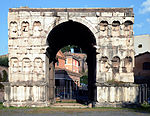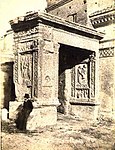Bocca della Verità

The Mouth of Truth (Italian: Bocca della Verità [ˈbokka della veriˈta]) is a marble mask in Rome, Italy, which stands against the left wall of the portico of the Santa Maria in Cosmedin church, at the Piazza della Bocca della Verità, the site of the ancient Forum Boarium (the ancient cattle market). According to enduring medieval legend, it will bite off the hand of any liar who places their hand in its mouth, or, alternatively, any who utters a lie while their hand is in the mouth. It still attracts many visitors who audaciously insert their hands. The massive marble mask weighs about 1300 kg (2800 lbs) and probably depicts the face of the sea titan god Oceanus. The eyes, nostrils and mouth are open. Historians aren't quite certain what the original purpose of the disc was. It was possibly used as a drain cover in the nearby Temple of Hercules Victor, which had an oculus—a round open space in the middle of the roof, similar to that of the Pantheon. Hence, it could rain inside. It is also thought that cattle merchants used it to drain the blood of cattle sacrificed to the god Hercules. In the thirteenth century the disc was probably removed from the temple and placed against the wall of the Santa Maria in Cosmedin. In the seventeenth century it eventually moved to its current location inside the portico of the church.
Excerpt from the Wikipedia article Bocca della Verità (License: CC BY-SA 3.0, Authors, Images).Bocca della Verità
Piazza della Bocca della Verità, Rome Municipio Roma I
Geographical coordinates (GPS) Address Nearby Places Show on map
Geographical coordinates (GPS)
| Latitude | Longitude |
|---|---|
| N 41.888055555556 ° | E 12.481666666667 ° |
Address
Santa Maria in Cosmedin
Piazza della Bocca della Verità
00153 Rome, Municipio Roma I
Lazio, Italy
Open on Google Maps










